by Usha Alexander
[This is the first in a series of essays, On Climate Truth and Fiction, in which I raise questions about environmental distress, the human experience, and storytelling. All the articles in this series can be read here.]
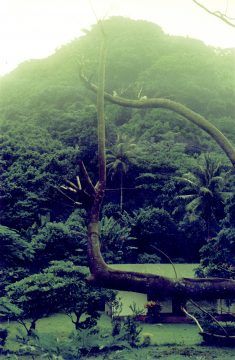 In 1997, I was living on Ambae, a tiny, tropical island in the western South Pacific. Rugged, jungle-draped, steamy, volcanic Ambae belongs to Vanuatu, an archipelago nation stretching some 540 miles roughly between Fiji and Papua New Guinea. There, under corrugated tin roofs, in the cinderblock classrooms of a small, residential school, I taught science to middle- and high-schoolers as a Peace Corps volunteer.
In 1997, I was living on Ambae, a tiny, tropical island in the western South Pacific. Rugged, jungle-draped, steamy, volcanic Ambae belongs to Vanuatu, an archipelago nation stretching some 540 miles roughly between Fiji and Papua New Guinea. There, under corrugated tin roofs, in the cinderblock classrooms of a small, residential school, I taught science to middle- and high-schoolers as a Peace Corps volunteer.
That December, the rainy season was in full force, with heavy downpours most afternoons, lasting sometimes long into the night. Never before had I, and never again would I, witness rains like those, where the water poured straight down, not in drops, but in globs and sheets. Standing in it felt like standing under a waterfall; I’d catch myself stepping forward or back, left or right, in an attempt to get out from under the flow, but it was everywhere. It seemed impossible that the sky could hold so much water, constricting summer’s broad daylight to a sodden gloaming.
One evening, during such a downpour, I left a teachers’ year-end potluck to return to my room—one in a row of tiny, concrete flats for the school’s single female staff. Mine was not much more than 100 yards away across an open lawn, which was now filled with ankle-deep water flowing gently down the long campus green toward the sea. As this was not my first deluge, I wasn’t concerned by the prospect of a routine water-logging; it was only water, after all, and not at all cold. The only problem was that the rains had washed away all light into a blind, enveloping darkness. I knew that once I stepped into it I would become disembodied, aware of my limbs only through my untrained sense of proprioception. How dependent we are upon the faculty of sight, even to know where we end and the external world begins.
Standing in front of the large, glaring light, which the principle had set up outside the classroom doorway, I pointed myself in the direction of my house. I held out my arms and stepped forward. Walking in perfect darkness feels like stepping in place, going nowhere. There’s only the light sensation of your feet tapping over a surface—or in this case, shuffling through a pool of water nearly indistinguishable from the cascade of water also flowing over my body. And at the time, I didn’t know that a person who tries to walk a straight line with no bearings will end up traversing an arc. But I continued moving, certain that after about a minute I would run into one of the papaya plants in front of my house. This did not happen.
At some point, I stopped. Surely, I’d been walking for too long. I groped around in the blackness, sidling a few steps this way and that, aware only of the invisible water washing over my invisible skin, the white rumble of the seemingly infinite waterfall striking the pool in which I stood, hoping that any moment the slick hardness of the papaya stem would strike my fingers—something solid in the empty dark. But it didn’t. Growing concerned that I might really get lost, I decided I should go back to the party. I turned around carefully, executing a 180º about-face, expecting the glaring light near the classroom doorway would serve as a beacon for my return. But it had vanished utterly, behind the consuming rain.
That moment of solitary, disembodied disorientation in the blackness was breathtaking; surreal. The entire world had dissolved away and I was a featureless monad floating in a watery void. If I yelled out, no one would hear me above the roar. If I kept wandering, I might stray into the jungle or onto the beach. If I stayed put, I would be stuck under a waterfall through a sleepless night, until the light arose enough to find home—though that home might even now be but inches beyond my reach. For awhile, I couldn’t move, sensorily adrift from everything I knew, uncertain where I was or what to do. But with every moment I stood there under the deluge, stranger questions began to drift out of the cracks in my mind. What if I never get back? What if I am wandering not in space, but in my own psyche? What if everything I thought was real was a dream, and now I am awake?
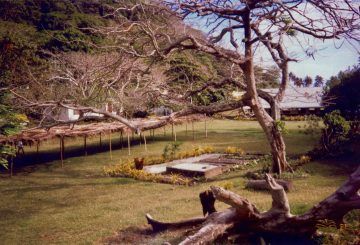 Tamping down the panic rising up through my brainstem, I decided to move slowly leftward, forward, leftward, forward, hoping the strategy might increase my chances of eventually running into the row of classrooms—provided I really was somewhere in the general vicinity of where I thought I should be. If I found one classroom, I might be able to feel my way along the row back to the potluck, or at least take shelter for the night. After what felt a long time—one minute? five minutes? fifteen?—at last, I discerned the muted glow of the beacon! I was steps away from the classroom door.
Tamping down the panic rising up through my brainstem, I decided to move slowly leftward, forward, leftward, forward, hoping the strategy might increase my chances of eventually running into the row of classrooms—provided I really was somewhere in the general vicinity of where I thought I should be. If I found one classroom, I might be able to feel my way along the row back to the potluck, or at least take shelter for the night. After what felt a long time—one minute? five minutes? fifteen?—at last, I discerned the muted glow of the beacon! I was steps away from the classroom door.
I tried to look casual as I burst back into the bright party, water streaming from my hair and clothes, probably trembling with quelled panic and the joy of re-encountering a material world. The gathered teachers surely worked to not roll their eyes at my folly, greeting me instead with bemused concern. One of them—possessing the more finely-honed sense of direction of a local, and a powerful pair of headlights—drove me home in the school truck, which was parked out front for this purpose. I had thought I was merely being independent and pragmatic to walk the short distance back to my house, but it turns out I was being foolish and naive about the weather. Maybe my life hadn’t been in real jeopardy that evening, but I was deeply affected by that experience. It became one of several lessons I had inadvertently learned about the weather in Vanuatu, one that sunk in right away.
Usually, when we talk about the weather, we call it small talk, an easy, inoffensive topic: everyone has experience of it, an opinion about it, while no one can take it personally or politically. Yet as we enter our present era of anthropogenic climate change, we are learning that the weather is not a small or benign matter. It is political. Its cycles and effects inform our choices, both personal and civilizational. Its consequences can alter the trajectory of a life. Or of a nation. It is experiential, affecting everything from our moods to our perceptions. The weather has everything to do with what it means to be human and how we live.
By January of 1998, a few weeks after that rainy night, I had moved to San Francisco. It was my first winter there after spending over a year in the tropics and the moderate cold stunned and depressed me. California was pounded by relentless rains that year, storms that washed away roads and houses and people. I had the unhappy sense that I’d somehow tracked a draught of rain with me from Vanuatu—and it struck me that, though the California rains were nowhere near as heavy as what I’d seen on Ambae, they were proving deadlier when they slammed into cities, roads, and buildings that were built for an arid climate.
It turns out that the rain from Vanuatu’s summer and California’s winter were indeed of a piece, caused by a phenomenon called El Niño: a cycle of intense warming in tropical Pacific waters. I would later learn that the 1997–98 El Niño had been the strongest ever, up to that time, and that while the unusually warm ocean was disrupting weather patterns across the planet during those years, it was also killing off some 15 percent of the coral reefs in the world’s first global coral bleaching event. In 2015–16, another El Niño of similar magnitude resulted in another devastating global coral die-off. As the world warms, such “super” El Niños may become more frequent. But warm water corals are faltering and dying in the warming oceans, even outside of these extreme events, and may be extinct by 2050.
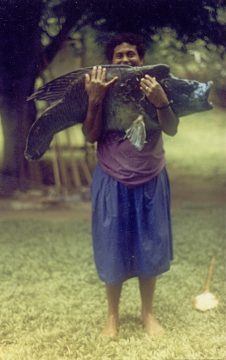 Knowledge of reefs and the sharks and fishes that live in and around them are part of Vanuatu’s ancient lore, and living there had brought the sea and its hidden depths much more into my land-lubber’s awareness. The Great Barrier Reef lies about a thousand miles west of Vanuatu, and while on the islands, I heard glowing descriptions of that astonishing colony creature from the many divers who passed through; though I couldn’t manage it at the time, I hoped to someday learn to dive and visit that coral cathedral, myself. In 1997, the idea that anything could threaten the life of Earth’s most massive living structure, thriving for over half a million years—since long before the appearance of modern humans on the planet—was beyond imagining. But a mere twenty years later, I would learn that literally half of the Great Barrier Reef had already died since I’d left the South Pacific, and the rest was unlikely to survive beyond another few decades.
Knowledge of reefs and the sharks and fishes that live in and around them are part of Vanuatu’s ancient lore, and living there had brought the sea and its hidden depths much more into my land-lubber’s awareness. The Great Barrier Reef lies about a thousand miles west of Vanuatu, and while on the islands, I heard glowing descriptions of that astonishing colony creature from the many divers who passed through; though I couldn’t manage it at the time, I hoped to someday learn to dive and visit that coral cathedral, myself. In 1997, the idea that anything could threaten the life of Earth’s most massive living structure, thriving for over half a million years—since long before the appearance of modern humans on the planet—was beyond imagining. But a mere twenty years later, I would learn that literally half of the Great Barrier Reef had already died since I’d left the South Pacific, and the rest was unlikely to survive beyond another few decades.
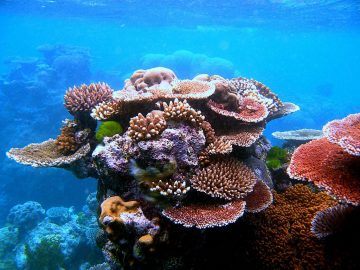
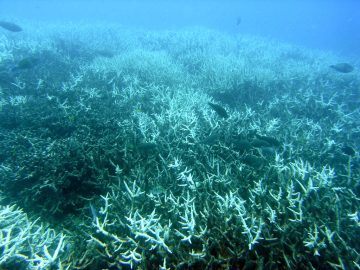 It was watching Jeff Orlowski’s 2017 documentary, Chasing Coral, that really brought home to me the profoundly dire condition of the world’s reefs. In the film, several scientists and technicians are seen crying as they talk about the future. And as their words sunk in, I joined them. It was my first wave of what some are calling climate grief. I already knew about climate change by this time, of course. I’d seen David Guggenheim’s 2006 film with Al Gore, An Inconvenient Truth. I’d lived with the California droughts and growing fire season. I’d read about the increasingly frequent heat waves in Europe and experienced them in India. I knew the Arctic ice cap was shrinking, that the glacier feeding India’s revered river Ganga was receding, and that sea levels were rising. All of this concerned me. But somehow it was the news of this impossible event, the abrupt demise of the most solid and ancient living thing on the planet—the momentous, fundamental shifts in our planet’s geology and living systems signaled by the death of the Great Barrier Reef—that became my personal tipping point. Something within me cracked open.
It was watching Jeff Orlowski’s 2017 documentary, Chasing Coral, that really brought home to me the profoundly dire condition of the world’s reefs. In the film, several scientists and technicians are seen crying as they talk about the future. And as their words sunk in, I joined them. It was my first wave of what some are calling climate grief. I already knew about climate change by this time, of course. I’d seen David Guggenheim’s 2006 film with Al Gore, An Inconvenient Truth. I’d lived with the California droughts and growing fire season. I’d read about the increasingly frequent heat waves in Europe and experienced them in India. I knew the Arctic ice cap was shrinking, that the glacier feeding India’s revered river Ganga was receding, and that sea levels were rising. All of this concerned me. But somehow it was the news of this impossible event, the abrupt demise of the most solid and ancient living thing on the planet—the momentous, fundamental shifts in our planet’s geology and living systems signaled by the death of the Great Barrier Reef—that became my personal tipping point. Something within me cracked open.
Climate grief has since never left me, but has proven increasingly corrosive to many of the illusions that surround and inhabit me, stories that legitimize the priorities and practices sustaining our contemporary lives. Those commonplace structures of meanings, values, and beliefs that power so much of the modern world, telling us what is true and what is real, have steadily crumbled and sloughed away from me. Now I am in search of new stories that can help me to understand and cope with what is happening and what lies ahead.
On Climate Truth and Fiction
These days—after decades of strategic obfuscation and delay—more and more gets written about climate change. As it has surged to the fore of mainstream media reportage and everyday conversation during the past two years (thank you for raising awareness, school-striking kids, Extinction Rebellion, and others!), people now talk about “fixing” climate change. To that end, we hear detailed discussion about alternative energy sources and grids: How many gigawatts each country needs to shift from burning coal to gas to solar panels and how quickly they can make the switch. How battery technology is or is not keeping up. How much carbon we have left to burn and how soon we can build great weather machines to remove it from the atmosphere. How carbon can be “traded,” “offset,” or otherwise pushed around by pens. Understanding all of these things—what works; what doesn’t; why and what else?—is essential in order to prevent the most extreme global heating from happening, or at least to slow it down.
Yet so much remains missing from the conversation. For as much as we need to understand the tradeoffs of battery chemistries, renewable energy sources, and geoengineering visions, technologies are only part of the story of how we’ll face our future. There’s so much more we need to talk about, when we talk about the weather. Like the profound, inescapable changes that lie ahead in our experience of the planet—even if we do everything right (which we won’t) to “safely” limit global heating. We need to talk about upheaval, dislocation, loss. Hunger. Fear. Migration. Meaning. We need to talk about grief. And resilience. Despite our faith in technology, the future of our civilization will ultimately be decided by far more essential considerations than battery storage or nuclear power; human thriving and resilience will finally not be measured only in gigawatts of energy and gigatons of carbon. It’s our collective attitudes, fears, desires, hopes, presumptions that will shape our options and our reality, just as they have always done. Just as they shape the present and how we see the past.
So, apart from trying to understand more about ice and oil and markets, I find myself searching for stories that plumb different aspects and levels of our human experience and what lies ahead. I’ve become obsessed with stories that engage with how we might encounter and adapt to our changing planet and the civilizational consequences of that change, stories that carry us from the world we knew to the world that is coming. Such stories can be fiction, non-fiction, or both. They can be stories about our planet, about living systems, the human experience, or an individual life lived. They just need to engage with reality in a truthful way.
I want to ask how the fluid darkness of an island night can—even for a moment—strip away everything you thought you knew was real and leave you gasping with the uninvited knowledge of how easily everything can be taken apart. All of it at the whims of a creation that engulfs you, inescapably, eternally. I want to ask how we might navigate our fear and uncertainty. About the irrepressible force of life, the powers of the wind and sun, sea and rain, fire and earth, which have always toyed with us, challenged our very experience of ourselves, and changed us, individually and in community. And what it means when we convince ourselves that it works the other way around—that we are the ones in command, or are god’s special creation. For I believe we won’t really begin to understand our moment on Earth and the new reality that lies ahead—nor find a salutary and holistic way to cope with it—without also considering the social, political, cultural, and other structural changes that have played a part in how we got to this moment, and how they might shape our responses to the challenges to come. I don’t pretend to have answers, but I hope to begin to grapple with some of these questions in a series of essays here on 3QD.
[Part 2: A Story of Fire and Ice]
Images
1. Early morning jungle, Ambae, 1997. During the rainy season, the growth is so aggressive that the green is almost monstrous; you can feel the jungle breathing.
2. Vureas school campus, Ambae, 1997. During the dry season, much of the tropical, semi-deciduous forest sheds its leaves. The school chapel is the largest building seen in the background; just beyond it is the double-row of classrooms.
3. Melody, my friend, 1997. She’s holding a fish she just spent all afternoon reeling in with a length of nylon string, a hook, and an empty water bottle for a fishing rod, as she paddled along the reef offshore of Ambae in her canoe.
4. Healthy corals in the Great Barrier Reef, 2010. Image by Toby Hudson, Creative Commons.
5. Bleached corals in the Great Barrier Reef, 2005. Image by J. Roff, Creative Commons.
